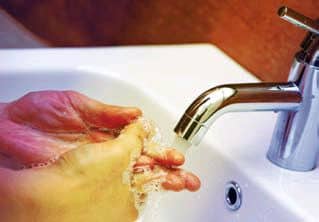by Jackie Dorst
Hand hygiene for the orthodontic team

Dorst
Audrey is an exceptional orthodontic chairside assistant who is fast, organized, and clean. She is so clean, in fact, that her hands are red, chapped, and hurting! Audrey’s irritation is called contact dermatitis.
What can be the cause of it? She wears nitrile gloves, so it’s not a latex allergy. Audrey washes her hands with soap and water about 80 times per day in her busy orthodontic practice, which sees an average of 80 patients per day. She washes with the antimicrobial soap that the office purchases by the gallon at a retail discount store. Audrey prefers to wash with soap and water, thinking that her hands will have fewer germs than if she used an alcohol-based hand rub. Her clean intentions are for good infection control and patient safety, but in reality, the infection control protocol in this orthodontic practice is compromised by Audrey’s red and chapped hands.
Audrey’s hands have more infectious microorganisms than healthy hands do. According to the book Practical Infection Control in Dentistry, “Healthy, intact skin is the primary barrier against infection. Skin damage changes the skin flora, resulting in more frequent colonization by staphylococci and Gram negative bacilli.”1 Soaps dry out skin by denaturing the stratum corneum proteins, changing intercellular lipids, and decreasing the water-binding capacity. Retail soap products do not contain emollients and humectants that health care professional hand hygiene products contain to lessen the damaging effects of frequent applications.
Audrey could further improve the condition of her hands by using a professional health care alcohol-based hand rub (ABHR) rather than soap and water for routine hand sanitizing. The Centers for Disease Control and Prevention’s 2002 Guidelines for Hand Hygiene in Health-Care Settings state, “In studies examining antimicrobial-resistant organisms, alcohol-based products reduced the number of multidrug-resistant pathogens recovered from the hand of Health Care Workers (HCW) more effectively than did handwashing with soap and water.”2

Using Alcohol Rubs
ABHRs are excellent for busy orthodontic professionals. Using ABHRs is faster than washing with soap and water, reduces the number of microorganisms on hands, and can condition skin with the added emollients. ABHRs contain 60% to 95% ethanol or isopropanol as an antiseptic ingredient that reduces the microbial flora on the skin. They also contain emollients such as 1% to 3% glycerol to prevent skin drying and dermatitis. However, since alcohol does not “clean,” if hands are soiled with blood, saliva, or any other proteinaceous material, then hands must be washed with soap and water. Also, soap and water should be used after every five to 10 ABHR applications because the emollients may build up.
The proper way to use ABHRs is to apply enough of the gel, foam, or rinse that it requires 15 seconds to dry with vigorous rubbing of hand surfaces, the spaces between fingers, and the fingertip pads.
Surgical alcohol hand rub formulations contain additional antiseptic agents for substantivity, meaning the agents adhere to the skin to provide an extended antimicrobial activity that prevents or inhibits the growth of microorganisms remaining on the skin. Antiseptic agents with substantivity include chlorohexidine, chloroxylenol (PCMX), and triclosan.
Choosing Hand Hygiene Products
Useful Web sites related to hand hygiene:
- who.int/gpsc/5may/en/
- cdc.gov/handhygiene/training/ interactiveEducation/
- cdc.gov/handhygiene
- justcleanyourhands.ca
- handhygiene.org
- Here is an entertaining and educational ABHR video. This University of Geneva video uses European Medical IC protocol, which varies slightly from the CDC Guidelines for the US.
Skin is the human body’s largest organ. Its primary functions are to reduce water loss, protect against abrasive action and microorganisms, and act as a permeable barrier to the environment. Hand hygiene is the single most important measure to prevent the transmission of infectious diseases in health care, but care must be taken to protect the skin when selecting and using hand hygiene products for busy orthodontic practices. Hand hygiene products for orthodontic practices include soap, antiseptic soap, ABHRs, surgical alcohol hand rub (for use when placing TADS or using a soft-tissue laser), lotion (latex compatible), and skin conditioning or barrier lotion.
For optimal hand hygiene and skin care, the orthodontic team should use the least irritating but effective hand hygiene products, plus lotions to ease dryness and prevent dermatitis. Health care professional hand hygiene products contain effective agents, clearly state compatibility with gloves and chemicals used in patient care, and include emollients to prevent drying and maintain healthy skin. Antimicrobial (antiseptic) handwash products and surgical hand scrubs contain an antiseptic agent such as alcohol, chlorohexidine, chlorine, iodine, chloroxylenol (PCMX), triclosan, or quaternary ammonium compound. They are regulated by the FDA’s Division of Over-the-Counter Drug Products.
It’s important to consider interactions between all hand hygiene products and gloves, orthodontic materials, and antimicrobial products. Lotions should be compatible with latex gloves if the orthodontic team wears latex gloves. Lotions that contain petroleum-based formulations can weaken latex gloves and increase permeability, but vinyl and nitrile gloves are not affected by petroleum-based lotions. In the antimicrobial category, chlorohexidine (CHG) can be inactivated by natural soaps, anionic surfactants, anionic hand creams, or anionic emulsifying agents. Another example of incompatibility is powdered gloves and ABHRs. Most orthodontic professionals prefer wearing powder-free gloves when using ABHRs because residual glove powder can mix with the alcohol and leave an uncomfortable, grainy feel on hands.
All team members should participate in the evaluation of hand hygiene products. After carefully reading the product label, evaluate the product for efficacy and compatibility in your orthodontic practice. Use samples in the clinical area for 1 week to 1 month. Orthodontic team members should pay careful attention to their hands during the evaluation period. Ask questions such as, “Is the product easy to use?” “Is skin condition improved?” and “Does the product feel good, smell good?”
Quality professional hand hygiene products protect orthodontic professionals’ hands and, when used properly, are the cornerstone of an effective orthodontic infection-control protocol. Take care of your hands so that you can continue to safely care for your orthodontic patients.
Jackie Dorst is a speaker and consultant on orthodontic instrument sterilization, infection control, and OSHA safety. She received her microbiology degree from the University of Georgia and her dental hygiene degree from Clayton State University. She can be reached at
References
- Molinari JA, Harte JA, eds. Practical Infection Control in Dentistry, 3rd ed. Baltimore: Lippincott Williams & Wilkins, 2010.
- CDC Guideline for hand hygiene in health-care settings: recommendations of health-care infection control practices advisory committee and the HICPAAC/SHEA/APIC/IDSA Hand Hygiene Task Force. MMWR 2002;51(RR-16):1-46.
Additional Reading
- Friedman C Petersen, KH. APIC Infection Control in Ambulatory Care, Jones & Barlett, 2004:31-38.
- Rutala, WA Disinfection, Sterilization and Antisepsis, Principles, Practices, Current Issues, New Research, and New Technologies, 2010 Edition, Association of Professionals in Infection Control and Epidemiology, 2010:84-89.










